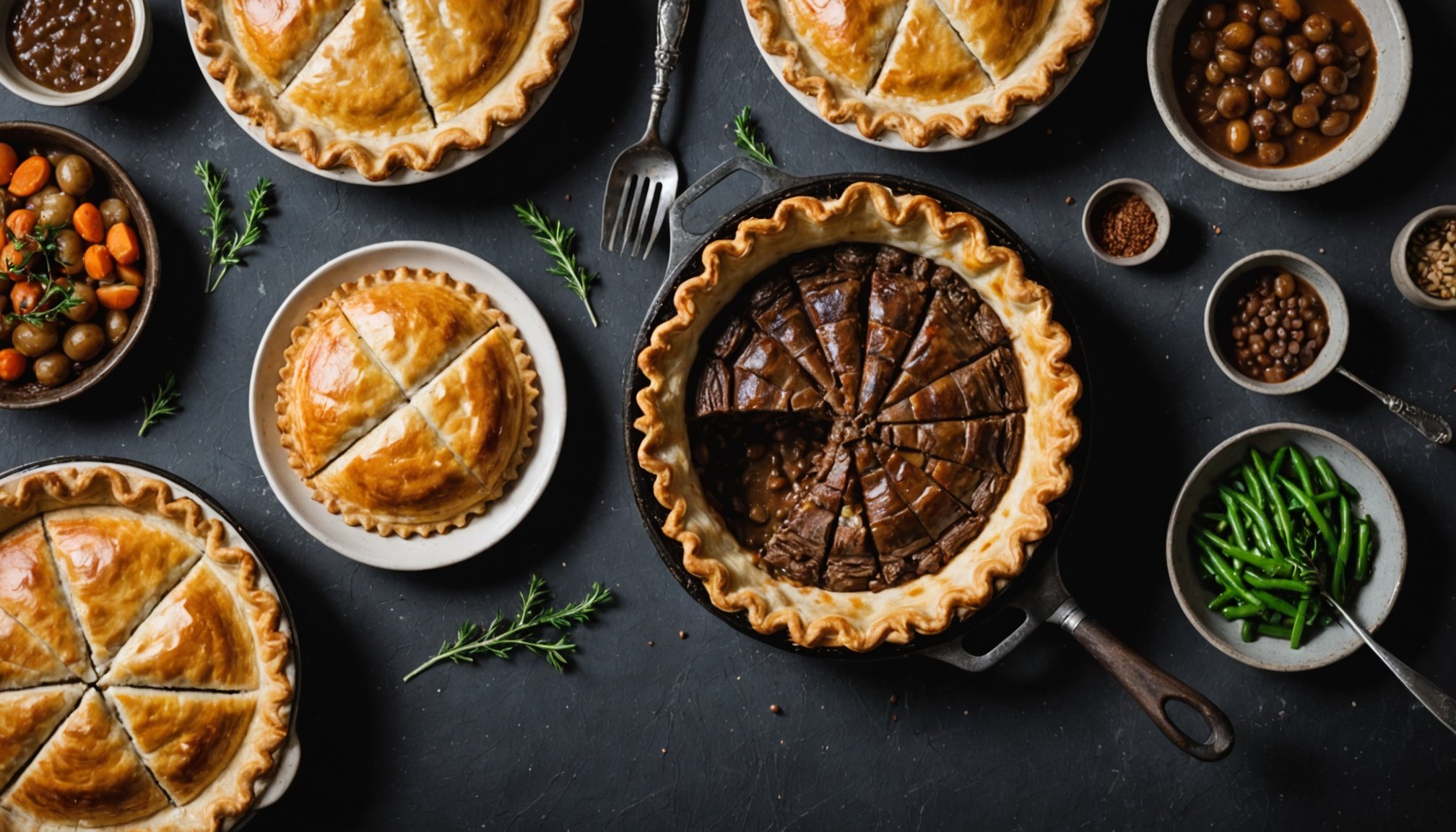Understanding Steak and Kidney Pie
Steak and kidney pie is a traditional British dish that boasts rich historical roots. This savoury delicacy primarily originated during the 19th century in Britain, becoming a staple comfort food. Its origins are linked to using locally sourced ingredients to create hearty meals, making it both economical and delicious.
The key components of this pie are straightforward yet crucial. High-quality beef steak paired with tender kidney forms the foundation, often enhanced with onions and a rich, flavourful gravy. The pie’s signature golden crust not only adds to its visual appeal but ensures a flaky, contrasting bite—a hallmark of any genuine steak and kidney pie.
Also to read : Unlocking the Secrets to a Delectable English Rhubarb Crumble: A Perfect Blend of Sweetness and Tartness!
Across the UK, regional variations provide a tapestry of interpretations. For instance, some areas might add bacon for a smoky depth, while others could incorporate stout to intensify the gravy’s richness. These variations celebrate local produce, showcasing the adaptability and enduring popularity of the pie throughout British culinary history.
Exploring the dish’s history and its diverse British adaptations can invigorate your appreciation for its continued presence on dining tables and in British culture. Each version offers a distinct twist while remaining anchored in traditional British culinary practices.
Also to discover : Zesty Perfection: Unlocking the Secrets to Exceptional Citrus Ceviche Techniques
Selecting the Right Ingredients
Choosing the right ingredient selection is pivotal to crafting a standout steak and kidney pie. The meat quality directly influences the dish’s overall flavour. Selecting the perfect cuts begins with high-quality beef; look for cuts like chuck or braising steak, known for their rich flavour and tenderness. When choosing kidneys, fresh ox kidney is ideal as it adds a robust, gamey taste to your traditional British dish.
In pursuit of freshness, always ensure both beef and kidney are bright in colour and have a pleasant, clean smell. Misjudging freshness can lead to off flavours and textures, ultimately detracting from the pie experience.
The pie crust holds the secret to achieving the perfect flaky finish. Quality plain flour and cold unsalted butter are essential. For a foolproof crust, consider a shortcrust variant. This type uses a simple ratio of flour to fat, creating that sought-after crisp texture. Maintaining cold ingredients during preparation prevents the butter from melting and ensures a flaky result.
Season your crust with a pinch of salt and consider incorporating a touch of sugar for depth. These best practices will set a solid foundation for your pie, allowing the richness of the filling to shine through harmoniously.
Mastering Cooking Techniques
Cooking a steak and kidney pie demands honing specific cooking techniques. Every element, from browning meat to perfecting pastry, plays a crucial role in achieving optimal flavour and texture.
Browning the Meat
Browning beef and kidney enhances flavour by creating a rich, savoury crust. To master this, heat your pan until it’s scorching hot. Introduce your meat in small batches, avoiding overcrowding. This allows each piece to form a caramelised exterior, adding depth and complexity to the dish.
Building the Filling
The filling is the heart of any traditional British dish like this pie. Start by using robust stocks and flavourful herbs such as thyme or bay leaves. Building the filling with these elements enriches the gravy and complements the key ingredients.
Perfecting the Pastry
Handling pastry dough requires patience. Keep your ingredients chilled to ensure flakiness. Gently roll the dough on a lightly floured surface, taking care not to overwork it. A delicate touch preserves the integrity of the crust, providing a crisp, golden finish atop your pie. Each step ensures a pie preparation that harmoniously balances texture and taste.
Cooking Methods and Baking
When cooking a steak and kidney pie, choosing the right cooking methods is crucial to achieving the perfect result. Different approaches, such as oven, stovetop, and slow cooking, each offer unique benefits. Opt for oven baking to ensure a uniformly cooked pie with a golden, flaky crust. Set the oven temperature to a consistent medium heat, ideally around 180°C (356°F), and bake for approximately one hour.
Proper baking instructions play a pivotal role in this traditional British dish. Glaze the crust with an egg wash before baking to enhance its appearance. Additionally, vent the top by creating small incisions to allow steam to escape, preventing a soggy interior.
If you choose slow cooking or stovetop methods, start by preparing the filling in a pan. This technique concentrates flavours over a longer period, ideal for tenderizing tougher meat cuts. Once the filling reaches the desired richness, transfer it to a pie dish with the pastry, and complete the cooking process in the oven for a perfectly baked finish.
These techniques are fundamental to achieving an expertly crafted steak and kidney pie, ensuring each component contributes to the dish’s overall success.
Serving Suggestions and Pairings
After creating your delectable steak and kidney pie, enhancing the dining experience with perfect accompaniments can elevate the dish. Ideal side dishes for this traditional British staple include creamy mashed potatoes or roasted seasonal vegetables. These sides complement the pie’s rich, savoury flavours without overpowering them.
To further enrich the meal, consider thoughtful beverage pairings. A robust red wine, such as a Shiraz or Cabernet Sauvignon, pairs excellently, as its bold notes balance well with the pie’s depth. For those preferring beer, a dark ale promises a harmonious match by accentuating the pie’s hearty character.
When presenting your pie, take a few presentation tips to ensure it looks as good as it tastes. Portion the pie in generous, evenly sliced pieces, ensuring a neat and appetising appearance. Garnish with a small sprig of fresh herbs like parsley for a touch of colour and freshness.
Each pairing and presentation choice can significantly enhance the overall enjoyment of your steak and kidney pie, showcasing the dish’s versatility and the attention to detail in your culinary preparation.
Troubleshooting Common Issues
Even seasoned cooks can encounter challenges when crafting the perfect steak and kidney pie. Recognising and addressing common problems ensures a delicious and satisfying result.
Undercooked Filling
An undercooked filling is often caused by insufficient cooking time or temperature. Allow the filling to simmer longer before assembly, ensuring tender meat and a rich gravy. Monitoring with a meat thermometer can gauge doneness accurately. If still facing issues, consider initial stovetop preparation to kickstart the cooking process.
Soggy Bottom Crust
A soggy bottom crust can be a chef’s nightmare. Prevent this by pre-baking the base (blind baking) before adding the filling. Ensure the pie dish is well greased, and opt for quality ingredients to improve texture. Additionally, adjust oven temperature to maintain even heat distribution throughout the baking cycle.
Flavour Adjustments
Mismatch in seasoning affects the pie’s depth. If overwhelmed by salt or under-seasoned, balance flavours with acidic or sweet components. Incorporate more herbs for a herbal note or tweak the spices for personal preferences. Adjustments in the final simmer can enhance the overall taste without overpowering the dish.
Variations of Steak and Kidney Pie
The steak and kidney pie serves as a canvas for culinary creativity. Across the globe, chefs have developed numerous pie variations, allowing the dish to transcend traditional British roots. Modern twists often involve ingredient swaps, such as substituting standard beef with venison for a more gamey flavour. These imaginative reinterpretations keep the dish fresh and exciting.
Culinary creativity also reflects in how cultural adaptations have influenced the pie. For instance, adapting the dish for various dietary needs is gaining popularity. Gluten-free crust alternatives or plant-based meats cater to a broader audience. These adjustments ensure everyone can appreciate the pie while honouring its traditional character.
International influences further extend the dish’s appeal. Australian versions might incorporate local spices, while in New Zealand, regional produce like kumara can become part of the filling. Each adaptation showcases the flexibility of traditional British dishes and their ability to blend with different tastes and preferences. Celebrating these interpretations invites a taste of global diversity while respecting the essence of a classic staple.
Expert Insights and Final Tips
Drawing on expert insights, refining your steak and kidney pie skills can enrich your culinary repertoire. According to professional chefs, the balance between time and temperature is crucial. Allowing the filling to simmer slowly ensures the beef becomes succulent, while the kidneys retain their inherent flavour. This patient approach is often the cornerstone of creating harmonious pie perfection.
In terms of cooking advice, chefs emphasize the importance of seasoning. Adding herbs like thyme or bay leaf can impart depth without overpowering the core ingredients. This technique enhances the natural flavours and brings a bouquet of aromas to the dish. When crafting your pie, experiment tastefully with these elements to find your ideal balance.
Avoiding common mistakes is vital for consistent results. One frequent misstep is overworking the dough, which can lead to a tough crust. Instead, handle with care to maintain its flaky texture. To further enhance crispness, some professionals recommend chilling the dough intermittently.
These cooking techniques and reminders serve as a guide to mastering this traditional British dish. Implementing these strategies not only boosts your confidence but guarantees a successful steak and kidney pie every time.










